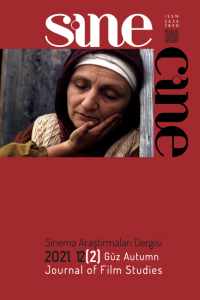KİAROSTAMİ’NİN ŞİRİN’İ ÜZERİNDEN SEYİRCİ VE SİNEMA DİLİNİN OLANAKLARINI YENİDEN DÜŞÜNMEK
Bu çalışma, Abbas Kiarostami’nin yönettiği Shirin (Şirin, 2008) bağlamında sinema, seyirci ve sinema dilinin seyirci üzerindeki etkileri üzerine yoğunlaşmaktadır. Kiarostami’nin kamerası bu kez bir sinema salonunda çoğunluğunu kadın seyircilerin oluşturduğu bir topluluğun bir film izlerkenki deneyimlerine yakın çekimlerle, sesin olanaklarını ve alan dışını kullanarak odaklanmayı seçer. Filmin içinde görmediğimiz ama seslerine tanık olduğumuz bir film daha vardır. Bu anlamda Şirin alışılmadık bir film izleme deneyimi sunarken beraberinde sinemanın kültürel boyutları ve seyir deneyimi ile ilgili olduğu kadar Kiarostami’den hareket ederek İran’da üretilen filmlerin üretilme dinamikleri üzerine de bir yorum getirme olanağı sağlar.
Anahtar Kelimeler:
Seyir, İzleyici, Bakış Açısı Çekimi, Seyir Deneyimi
Revisiting the Abbas Kiarostami’s Şirin in Context of the Cinema, the Audience, and the Possibilities of Cinematography
This article examines the ways in which Abbas Kiarostami used cinematographical techniques such as close-up, sound manipulation, and offscreen space to create a parallel “world” for the audience of Şirin, his last film. He placed the camera in a cinema, looking at the audience, and that is what Kiarostami’s audience sees; one audience watches another audience while that other audience watches a film. A series of intense closeups reveal the effect that the film has on individuals in the audience. One never sees the film they are watching; one only hears the soundtrack. Kiarostami is a prestigious Iranian filmmaker, and this film also provides an opportunity to discuss the cultural and ideological dynamics of filmmaking style and production procedures in Iran.
Keywords:
Audience, Spectatorship, Point of View Shot, Cinematic Experience,
___
- Arslan, U.T. (2009). Aynanın Sırları: Psikanalitik Film Kuramı. Kültür ve İletişim, 12(1), 9-38.
- Boggs, J. & Petrie, D.W. (2000). The Art of Watching Films (5. Baskı). USA: Mayfield.
- Bonitzer, P. (1995). Bakış ve Ses (İ. Yasar, Çev.). İstanbul: YKY.
- Bonitzer, P. (2006). Kör Alan ve Dekadrajlar (İ. Yasar, Çev.). İstanbul: Metis.
- Bordwell, D. & Thomson, K. (1997). An Introduction to Film Art. USA: The McGraw-Hill.
- Bordwell, D. & Thomson, K. (2008). Film Sanatı (E. Yılmaz & E. S. Onat, Çev.). Ankara: De Ki.
- Branigan, E. (1984). Point of View in the Cinema: A Theory of Narration and Subjectivity in Classical Film. Berlin: Mouton Publishers.
- Calhoun, D. (T.Y.). Binoche: Interview. http://www.timeout.com/film/features/showfeature/5589/juliette-binoche-interview.html
- Chatman, S. (2008). Öykü ve Söylem: Filmde ve Kurmacada Anlatı Yapısı (Ö. Yaren, Çev.). Ankara: De Ki.
- Choi, J. (2005). Leaving it up to the Imagination: POV Shots and Imaging from the Inside. The Journal of Aesthetics and Art Criticism, Kış, 6(1), 17-25.
- Ferahmend, A. (2007). Son Dönem İran Sineması (Uluslararası Ba!arısı) Üzerine Perspektifler (K. Sarısözen, Çev.). R. Tapper (Ed.), Yeni İran Sineması: Siyaset, Temsil ve Kimlik (s.107-135). İstanbul: Kapı.
- Kalari, M. (1999). Monsieur Kiarostami Siz Kimsiniz? Abbas Kiarostami’nin Dünyası. (M. Tatar, Çev.). 25. Kare, 29, 63-66.
- Kanbur, A. (1999). Kom!unun Evi Nerede? İranlı Yönetmenler “Dışarı”da Dolaşıyor. 25. Kare, 28, 63-69.
- Khodaei, K. (2009). Shirin as Described by Kiarostami. Offscreen 13(1). http://www.offscreen.com/biblio/pages/essays/shirin_kiarostami/
- Kırel, S. (2006). Küresel Seyircilik, Hollywood ve “Öteki” Sinemalar Bağlamında İran Filmlerinin Konumlandırılması. İletişim: Galatasaray Üniversitesi İletişim Fakültesi Dergisi, 4, 51-69.
- Kırel, S. (2007). İran’da Sinema: İran Sineması ve Üretim Dinamikleri ve Anlatıya Etkileri Üzerine Bir Değerlendirme. (E. Biryıldız & Z. Ç. Erus, Ed.), Üçüncü Sinema ve Üçüncü Dünya Sineması (s.355-417). İstanbul: Es.
- Lord, C (2009). Legendary Filmmaker Abbas Kiarostami Tells Time Out the Burden of Narratives. http://www.timeoutdubai.com/art/features/7962-abbas-kiarostami
- Lotman, M.Y. (1999). Sinema Estetiğinin Sorunları: Filmin Semiotiğine Giriş (2. Baskı, O. Özügül, Çev.). Ankara: Öteki.
- Mascelli, J. V. (2002). Sinemanın Beş Temel Ögesi (H. Gür, Çev.). Ankara: İmge.
- Metz, C. (1992). Aural Objects. G. Mast, L. Braudy & M. Cohen (Ed.), Film Theory and Criticism: Introductory Readings (4. Baskı, s.313-316). NewYork: Oxford University.
- Mulvey, L. (1996). Fetishism and Curiosity. Londra: Indiana University.
- Mulvey, L. (1997). Görsel Haz ve Anlatı Sineması (N. Abisel, Çev.). 25. Kare, 21, 38-46.
- Mulvey, L. (2007). Sonsöz (K. Sarısözen, Çev.). R. Tapper (Ed.), Yeni İran Sineması: Siyaset, Temsil ve Kimlik (s.317-326). İstanbul: Kapı.
- Murray, S. (1994). Altered States: Character and the Emotional Response in the Cinema. Cinema Journal, 33 (4), 34-56.
- Naficy, H. (1997). İran’da İslamize Film Kültürü. (E. Özen, Çev.). 25. Kare, 18, 58-69.
- Naficy, H. (2001). An Accented Cinema: Exilic and Diasporic Filmmaking. USA: Princeton University.
- Naficy, H. (2006). Theorizing “Third World” Film Spectatorship: The Case of Iran and Iranian Cinema. J. Codell (Ed.), Genre, Gender, Race and Global Cinema (s.369-387). Londra: Blackwell.
- Nizami. (1955). Hüsrev ve Şirin (S. Sevsevil, Çev.). İstanbul: Maarif.
- Özön, N. (2000). Sinema, Televizyon, Video, Bilgisayarlı Sinema Sözlüğü. İstanbul: Kabalcı.
- Pourmand, A. (2009). Kiarostami Yearns for Iranian Premieres After 12 Years. http://www.payvand.com/news/09/mar/1096.html
- Rosenbaum, J. (2008). Kiarostami’s Shirin: A Fiction. http://www.jonathanrosenbaum.com/?m=200808
- Scheib, R. (2008). Shirin. http://www.variety.com/review/VE1117938104.html?categoryid=31&cs=1
- Shirin (T.Y.). http://www.imdb.com/title/tt1284587/
- Sheibani, K. (2006). Kiarostami and the Aesthetics of Modern Persian Poetry. Iranian Studies. 39(4), 509-537.
- Smith, M. (1995). Film Spectatorship and the Institution of Fiction. The Journal of Aesthetics and Art Criticism, 53(2), 113-127.
- Sözen, M. (2008). Sinemasal Anlatıda Bakış Açısı Kavramı ve Örnek Çözümlemeler. Selçuk Üniversitesi Sosyal Bilimler Enstitüsü Dergisi, 20, 577-596.
- Stanley, R.H. (2003). Making Sense of Movies: Filmmaking in the Hollywood Style. USA: McGraw Hill.
- Vaziri, P. (2002). Iranian Documentary Cinema Between Reality and Fiction. Middle East Report, 225, 53-54.
- ISSN: 2636-784X
- Yayın Aralığı: Yıllık
- Başlangıç: 2010
- Yayıncı: Semire Ruken Öztürk
Sayıdaki Diğer Makaleler
Filmde ve Medyada Feminizmin Durumu
İSLAMCI FİLMLERDE KADIN TEMSİLİ
1950'LER SİNEMA ORTAMINDA ŞAKİR SIRMALI'NIN SÖYLEMİNİN ETKİSİ
Kiarostami ve Modern Fars Şiiri Estetiği
2000’li Yıllarda Sinemaya Bir Bakış
KİAROSTAMİ’NİN ŞİRİN’İ ÜZERİNDEN SEYİRCİ VE SİNEMA DİLİNİN OLANAKLARINI YENİDEN DÜŞÜNMEK
1950'LER SİNEMA ORTAMINDA ŞAKİR SIRMALI'NIN SÖYLEMİNİN ETKİSİ
